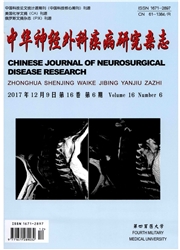

 中文摘要:
中文摘要:
目的探讨运用颅内电极埋藏进行视频脑电图监测在定位困难的枕叶癫痫中的作用。方法通过对9例枕叶癫痫但定侧定位困难的患者,向颅内可疑部位植入硬膜下条状电极,进行视频脑电图监测,记录发作间期及发作期脑电图变化,确定癫痫病灶起始区。通过手术切除致痫灶。结果本组9例埋藏时间为3~9d,平均5d,均记录到间歇期痫样放电及发作期脑电图情况。行枕叶局部皮层切除6例及枕叶切除3例。术后按照Engel评分,I级7例,II级2例。所有病例均未出现埋藏电极引起的并发症。结论在致痫灶定位困难的顽固性枕叶癫痫中,采用颅内电极埋藏进行脑电图监测,可以精确定位致痫灶,从而提高癫痫的治愈率。
 英文摘要:
英文摘要:
Objective To investigate the effect of video electroencephalogram (EEG) recording by intracranial electrode implantation in patients with occipital lobe epilepsy for seizure foci location.Methods Nine cases of intractable occipital lobe epilepsy patients underwent video EEG monitoring by implantation of subdural grid and strip electrodes. EEG changes during the onset or in the interval were recorded to locate seizure onset zone. All the seizure foci were resected by surgery.Results The intracranial electrode recoding detected the seizure foci within 3~9 d (average 5 d) after the electrode implantation. Interictal epileptic discharges were recorded and ictal EEG was obtained from predicated location in all patients. The surgical outcomes included 7 cases of Engel class I and 2 cases of Engle class II. No complication occurred due to the electrode implantation. Conclusion For the intractable occipital lobe epilepsy with difficulty in location of seizure foci,EEG monitoring by electrode implantation would make it a possibility of accurate location of seizure foci to improve the cure rate of epilepsy.
 同期刊论文项目
同期刊论文项目
 同项目期刊论文
同项目期刊论文
 Relief of carotid stenosis improves impaired cognition in a rat model of chronic cerebral hypoperfus
Relief of carotid stenosis improves impaired cognition in a rat model of chronic cerebral hypoperfus 期刊信息
期刊信息
